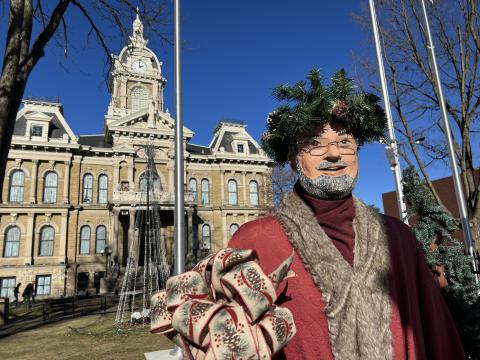This Ohio town lets you visit Christmas Past; no ghost required

Listen to this Episode
A stroll down the main street in Cambridge looks a lot different in December. The quiet, quaint town gets unusually busy. Its benches are filled with couples carrying presents. Carolers stand on the edge of the sidewalk. Salesmen peddle candles and apples.
Although the population grows, the newcomers don’t make a peep. These aren’t citizens, or visitors or even people: they’re mannequins.
“There’s about 170 mannequins out on our street,” said Julie Davey, the manager of the Dickens Victorian Village Welcome Center.
Each winter, Cambridge transforms from a small Ohio town into an English Victorian Village out of a Charles Dickens book. Locally made mannequins line the street and peep out of storefronts. They act out scenes of “A Christmas Carol” and give a historical look into 19th century England. And they attract big numbers for the small city.
“We literally bring thousands of people downtown in the two months,” Davey said.

An annual tradition
The event began 18 years ago. It was the brainchild of a local couple, Bob and Sue Ley.
“He and his wife were kicking around ideas. We need to get people back downtown here because we're losing our stores. We're losing our visitors. They're going out to the bigger cities, to the strip malls,” Davey said.
Ley admired the work of Dickens and noticed that the small city had remnants of Victorian-era architecture. That sparked the idea to create Cambridge into a must-see Christmas destination. Not through tinsel or garland or a shiny tree in the center of town, but through something a bit more old-fashioned.
Bob started sketching some designs of figures like Ebeneezer Scrooge, Tiny Tim, Bob Cratchitt and Dickens himself. He dreamed up a town crier, a violinist and a delivery man. He just needed help building them. That’s where local teachers, like Cindy Arent, came in.
“First grade teachers, we were good with duct tape,” said Arent, the head of the Creative Team.
Arent and her team of teachers fashioned planks of wood into a skeleton and stuffed them with carpet or bubble wrap. They shaped heads with styrofoam and clay. Finally, they dressed the figures – the men in thrift store finds, the women in custom-made dresses – then put them out on display.
A labor of love
The town is protective of their crafted neighbors. Volunteers like Arent take special care to ensure the mannequins, and their outfits, survive the winter elements. Each year, they mend any scrapes and refit the well-worn mannequins into fresh apparel.
“We know where all the wind tunnels are downtown. We know how many gallon jugs of sand have to be under each platform to keep it from blowing into the street,” Arent said. “It’s a science.”
Arent said they care deeply about the details, ensuring everything is fit for the Victorian period. And the mannequins aren’t the only ones who model the English fashion. It’s not uncommon to see volunteers like Arent in period hats and gloves, with skirts that ruffle and swish with each step.

Perhaps the best dressed is Queen Victoria herself, or, as the locals know her, Connie Humphrey. She portrays the royal figure for students, bus tours and the annual Christmas parade, speaking about the Queen’s reign and breathing a little life into the village of static statues.
“As soon as I walk into that room: Tada! The Queen has arrived,” Humphrey said. “I couldn't get paid for this job. There is not a salary that would make me happy the way making people happy moves me.”
Everyone has their part. The high school football players put up the mannequins’ platforms. Crafty residents sew new garments. The local librarians ensure everything is historically accurate. The two-month display is completely volunteer run and nothing is outsourced.
And, though the village will wrap up at the end of December – the mannequins taken down and put in storage – the Christmas spirit in Cambridge stays alive all year. In January, the community of volunteers will start preparations for the next season.
“It's been a project here that has lit fires in a lot of people who thought they weren't needed anymore,” Humphrey said. “And now something that they took on as a hobby is now a vital part of this village.”
9(MDYwODMwNTczMDE2ODk5NTExNDAyNzM5Ng000))
- Home
- Schedules
- TV
- TV
- Local TV Programs
- Business | Life 360 with Kristi K.
- Toledo Stories
- To The Point with Doni Miller
- Listening with Keith Burris
- Ideas & Insights
- WGTE Presents
- BL360: Northwest Ohio Innovation Consortium
- Magic of the Old West End
- Freedom Means Never Surrender
- I&I: The Random Factor
- FF: National Cherry Festival
- TTP: Moms Demand Action For Gun Sense in America
- Watch Live
- Radio
- Education
- Community
- Support
- About
- Donate
- Watch Live


